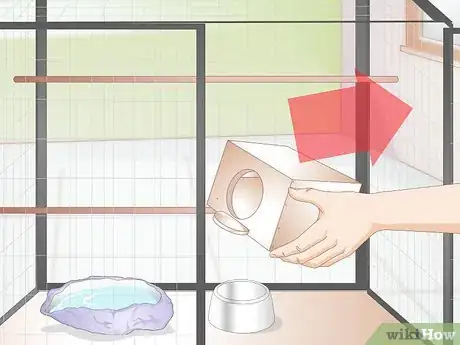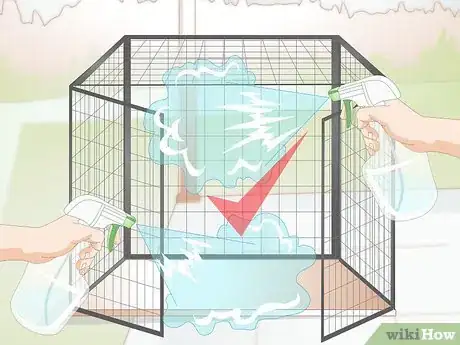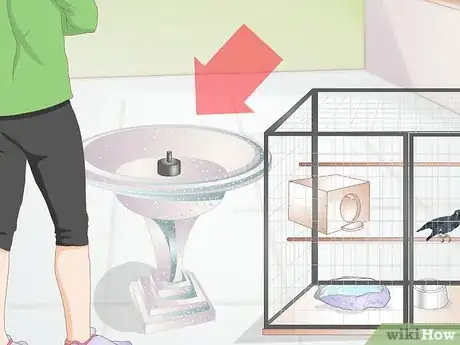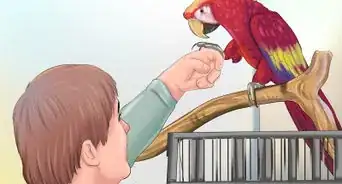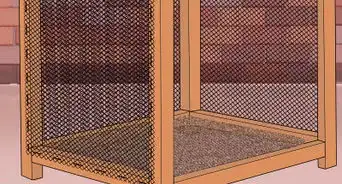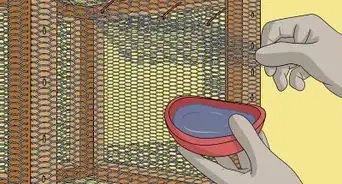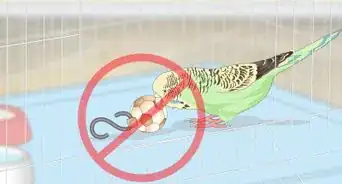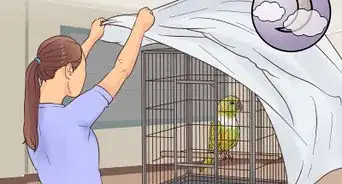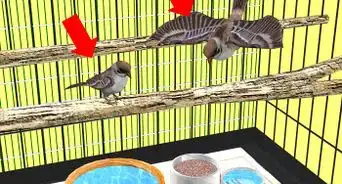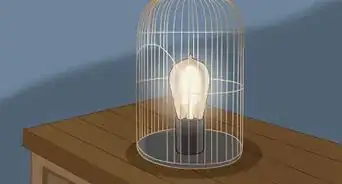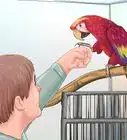This article was co-authored by Pippa Elliott, MRCVS. Dr. Elliott, BVMS, MRCVS is a veterinarian with over 30 years of experience in veterinary surgery and companion animal practice. She graduated from the University of Glasgow in 1987 with a degree in veterinary medicine and surgery. She has worked at the same animal clinic in her hometown for over 20 years.
There are 9 references cited in this article, which can be found at the bottom of the page.
wikiHow marks an article as reader-approved once it receives enough positive feedback. This article received 17 testimonials and 92% of readers who voted found it helpful, earning it our reader-approved status.
This article has been viewed 125,135 times.
Keeping a pet bird can be a lot of fun, but there is also a lot of responsibility that comes with it. One of the biggest responsibilities is cleaning the bird cage. A clean cage and cage accessories help keep your bird happy and healthy. By allowing for proper daily and weekly cage cleanings, along with weekly baths for your bird, you can help keep out harmful debris and bacteria and keep your bird in good health.
Steps
Cleaning for Daily Sanitation
-
1Clean out the dishes. Food and water dishes should be cleaned out every day using hot water and dish soap. Rinse the dishes before lathering with soap, then rinse the soap off under hot water for several seconds. Once the bowl is clean, dry thoroughly with a clean towel.[1]
- Some dishes may be dishwasher safe. Check to make sure that your dishes are dishwasher safe before placing them in the dishwasher, and make sure you use an animal-safe detergent.
- Animal-safe dish soaps and detergents are often available at local pet stores, online, or in grocery stores that carry environmentally-friendly cleaning products.
- It may also be useful to have two or three sets of dishes on hand if you do not have time to properly clean and dry the dishes every day.
- Often, the bird can stay in the cage during daily cleanings. However, if you think the bird is a flight risk, you may want to consider keeping an alternate cage where the bird can stay while you clean.
-
2Inspect the cage accessories. If you have a birdbath, swings, ladders, or other toys, wash them in hot, soapy water the same way you do the dishes. Scrape droppings off perches and rotate the perches to ensure they wear evenly.[2]
- When you replace the toys in the cage, consider moving them around to give your bird variety and additional stimulation.
Advertisement -
3Change the liner. Your bird cage liner should be replaced every day. Newspaper or other store-bought paper linings are generally the preferred lining for your bird cage, as they are safe, economical, and easy to check for droppings. Remove the old liner completely, using a damp rag or sponge to take up any paper that sticks, and place the new paper down in several thin layers.
- Newspaper lining or any other recycled paper lining should be free of colored ink, as some pigments used in some inks may be toxic to birds.
- Try to have at least seven layers of paper down to catch and absorb all debris and droppings.
-
4Sweep up the surrounding areas. Use a handheld broom or vacuum to sweep up the areas surrounding the cage to pick up food, feathers, droppings, and other debris that may have fallen out of the cage. Wipe up any water or moisture that may have spilled into the surrounding area, as well.
- A cage apron can be used to help collect debris falling out of the cage and may be easily emptied every day. These are available at pet stores as well as specialty bird stores.
- If your cage is in a carpeted area, a plastic floor liner such as a placemat or a mat that might go under an office chair can help catch debris and may be easily sanitized.
Sanitizing the Cage Regularly
-
1Pick a cleaning schedule. How frequently you need to sanitize your cage depends on a number of factors including the size of the cage, the size of your birds, the number of birds you have, and how much time daily your birds are in the cage. Find a cleaning schedule that meets the needs of your specific set-up.
- Smaller cages with individual birds may only need to be sanitized once a month, especially if the bird is regularly let out of the cage.
- Large cages for large birds or cages for multiple birds should be sanitized weekly.
-
2Remove everything. Move your bird into a safe area such as an alternate cage and take all toys and accessories out of the cage to wash as you would for a daily washing. Remove the old liner and leave the cage bare.[3]
- It is important to keep your bird in an area free from any exposure to fumes or excess product while you are cleaning your cage.
- Remember to wash any dishes and cage accessories in hot, soapy water before returning them to the clean cage.
-
3Scrape away debris and droppings. Remove debris and droppings from the cage using a pet-friendly soap or washing detergent and a scrubbing pad. Scrape them off of any of the cage surfaces, as well as off of perches and toys.[4]
- Sandpaper can be useful in removing stubborn debris from wooden perches or toys.
-
4Wash the cage. Use hot, soapy water to wash down the cage completely, then rinse thoroughly removing all soap and suds. This may be manageable in a sink for smaller cages, but larger cages may require a shower or use of a hose outdoors.[5]
- An animal-safe dish soap or detergent is sufficient for this stage in the cleaning process.
- For better results disinfecting, use a clean towel to lightly dry the cage and soak up any excess water pooling around the cage’s surfaces.
-
5Disinfect the cage. Once the cage has been washed, spray the cage from top to bottom with a cage disinfectant spray. Disinfectant sprays meant specifically for bird cages may be bought online or purchased at a local pet or bird specialty store. Rinse the cage thoroughly with water and allow to air-dry completely before returning the bird.[6]
- Some people opt to use a vinegar cleaning solution of one part distilled white vinegar and two parts water. Another homemade solution is three cups hot water, three tablespoons baking soda, and three tablespoons lemon juice.
- If you do not have the means to spray the disinfectant on the cage, thoroughly wipe down every surface with a clean towel soaked in the disinfectant solution. Remember to use protective gloves whenever handling the disinfectant.
-
6Refill the cage. Once the cage has been sanitized, rinsed, and dried you are ready to replace all dry perches, toys, dishes, and other cage components. Place in the clean cage lining and make sure the apron and surrounding area are clean and free of debris before allowing your bird back in.
- Do not put wet or unrinsed components back in the cage, as these may cause harm to your bird or otherwise hinder their movement and access to parts of the cage.
Keeping Your Bird Clean
-
1Choose a birdbath. Bathing your bird regularly is just as important to its overall health as cleaning the cage. Choose a birdbath that is appropriately sized for your bird so that it will not have trouble getting in and out of the basin.[7]
- Some birdbaths are meant for use inside the cage, while some are meant for use outside the cage. Larger birds may benefit from external baths, but bath setup largely comes down to owner preference.
- If you have a bird that can swim, such as a duck, make sure the bath contains enough space and water for the bird to be able to dunk their head safely.
-
2Use warm water. Allow the bird to use the bath only with your supervision. Fill the bath with warm water, and allow the bird to splash around, getting itself wet and preening for several minutes before removing it from the bath.[8]
- Once your bird has finished bathing, scratch against the feathers to imitate mutual preening. Be sure not to press the feathers down against the bird’s body, as birds do not enjoy this sensation.
-
3Allow the bird to dry. Your bird will need time enough to dry before the evening. Allowing a bird to bathe too close to bedtime could lead them to getting dangerously cold during the night. Make sure your bird has at least a few hours to dry fully, especially for large birds.[9]
- If you live in a colder environment, make sure the room is well-heated while your bird is bathing as well as when it is drying off.
Warnings
- Do not use cat litter, wood chip, or corncob for the lining, as the dust they give off is harmful to birds.⧼thumbs_response⧽
Things You'll Need
- Bird cage
- Animal-friendly soap or detergent
- Warm water
- Bird cage disinfectant solution
- Paper for cage lining
- Sponge or rag to clean the cage with, not to be used for other animals
References
- ↑ http://petcha.com/pets/best-ways-to-clean-a-pet-bird-cage-mess/
- ↑ https://lafeber.com/pet-birds/dont-leave-these-in-your-birds-cage-2/
- ↑ http://petcha.com/pets/10-tips-to-cleaning-your-pet-bird-cage/
- ↑ http://petcha.com/pets/tips-to-clean-the-pet-bird-mess/
- ↑ http://petcaretips.net/cleaning-bird-cage.html
- ↑ http://www.peteducation.com/article.cfm?c=15+1794&aid=2837
- ↑ http://www.birds.cornell.edu/AllAboutBirds/notes/BirdNote09_ProvideWater.pdf
- ↑ http://pets.thenest.com/bathe-parakeets-7242.html
- ↑ https://www.vetbabble.com/birds/bird-cleaning/
About This Article
To clean a birdcage, start by washing the food and water dishes daily with hot water and soap and changing the liner. If you have a birdbath, swings, ladders, or other toys, wash them in soapy hot water as well. Additionally, empty the bird cage completely every few weeks before scraping away any debris or droppings. Then, rinse the cage with hot water, spray it with a special bird-friendly disinfectant, and rinse it down again with hot water. For more tips from our Veterinary reviewer, including how to keep your bird clean, keep reading!





